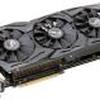AMD’s new Radeon RX 500 series is here, and we’re ready with new graphics cards. The ROG Strix RX 580 and 570 pair our latest technologies with updated Polaris GPUs and up to 8GB of GDDR5 memory.
Although they differ in some areas, our new Strix RX 580 and 570 graphics cards share a collection of common features that improve cooling, aesthetics, and reliability. The cooling enhancements start with 0dB wing-blade fans that spin down completely when the cards are idling or under lighter loads. This automatic stealth mode lets the Strix operate in blissful silence when you’re surfing the web, watching movies, and even playing less-demanding games.
Games and VR hit the GPU much harder than other components, which presents a problem for system fans that normally adjust their speed based on motherboard or CPU temperatures. Those components simply don’t heat up as much under the same loads, but we have a solution. The ROG Strix RX 580 and 570 come with FanConnect II headers that let you link system fans directly the to the graphics card. These fans are controlled by the same intelligence as the ones on the card, ensuring optimal cooling for gaming and other graphics-heavy tasks.
RGB lighting is everywhere for good reason. People are easily distracted by bright, shiny things—but more importantly, they want to personalize their builds. With a full spectrum of colors and multiple effects, the Aura Sync lighting on our new Strix cards allows easy customization to suit your style.
There’s more to good lighting than just adding multicolored LEDs, though. Since the whole point is letting you choose the colors yourself, our cards have monochromatic palettes that won’t clash with your build. And we go one step further with Aura Sync, which synchronizes colors and effects with other system components, including compatible ROG motherboards and peripherals, and select ROG-certified chassis and memory modules. As with cooling, we view lighting as a full-system solution—not just another checkbox feature.
Extra flourishes would be pointless if we didn’t get the basics right. ASUS graphics cards are built using Auto-Extreme technology, a fully automated manufacturing process that ensures consistent quality. The Strix cards are populated with premium components, and their fans are IP5X-certified for dust resistance. You can rest assured knowing that your investment is reliable enough for the long haul.
The ROG Strix RX 580 goes to the Top
Rather than reprising the cooler from the previous generation, the ROG Strix RX 580 series uses the latest design we introduced with the Strix GTX 1080 Ti. At 2.5 slots wide, this monster dissipates heat across 40% more surface area than the old 2-slot cooler. The copper slug that sits on top of the GPU is also machined with much tighter tolerances to improve thermal transfer. Dubbed MaxContact, this precision-crafted surface is 10X flatter than traditional heat spreaders.
While the RX 580 offers a more premium experience that’s ready for VR, the RX 570 is designed for turning up the details at the 1080p resolution used by most gamers. The cooling requirements are lighter, allowing the Strix RX 570 to use a dual-slot DirectCU II heatsink with two fans rather than three. The card also has one FanConnect II header for attaching a system fan.
There are two versions of the Strix RX 570, both of which come with 4GB of GDDR5 memory on a 256-bit interface. The standard model boosts the GPU clock up to 1254MHz in OC mode and 1244MHz in Gaming mode, while the OC variant pushes those frequencies to 1310/1300MHz. You’re free to overclock the cards further with GPU Tweak II, of course.
The RX 570 isn’t meant for VR, so the Strix cards have a single HDMI 2.0 port along with DisplayPort 1.4 and dual DVI. You can power a 4K monitor or big-screen TV at 60Hz, and compatible displays can take advantage of the smoother, tear-free gameplay that AMD’s FreeSync technology provides.
Aura Sync lighting is confined to a single badge on the edge rather than being spread across the front and back like the Strix RX 580, making the card subtler than its big brother. Streamers still get a premium license for XSplit Gamecaster, but it’s limited to 14 days—long enough to figure out whether you want to play for an audience or just yourself.
ASUS alternatives on multiple fronts
While the ROG Strix cards put gamers first, ASUS also offers other flavors. The Dual Radeon RX 580 keeps the dust-resistant 0dB fans and VR-friendly output configuration of its Strix sibling, but it opts for a dual-slot cooler with two fans and no RGB LEDs. Two versions are available: an OC edition that boosts up to 1380MHz in OC mode and 1360MHz in Gaming mode, and a standard edition clocked at 1360/1340MHz. Both come with 4GB of GDDR5 memory and a stylish black cooler with white accents.
One step down the GPU ladder, the Expedition RX 570 provides an affordable alternative that’s ready for continuous play. Its dual-ball-bearing fans last two times longer than the sleeve-bearing fans found in lesser cards, while 0dB tech eliminates fan noise under lighter loads. You can choose between an OC version that boosts up to 1266MHz in OC mode and 1256MHz in Gaming mode and a standard model clocked at 1254/1244MHz. Both are equipped with 4GB of GDDR4 memory along with HDMI 2.0, DisplayPort 1.4, and DVI outputs.





